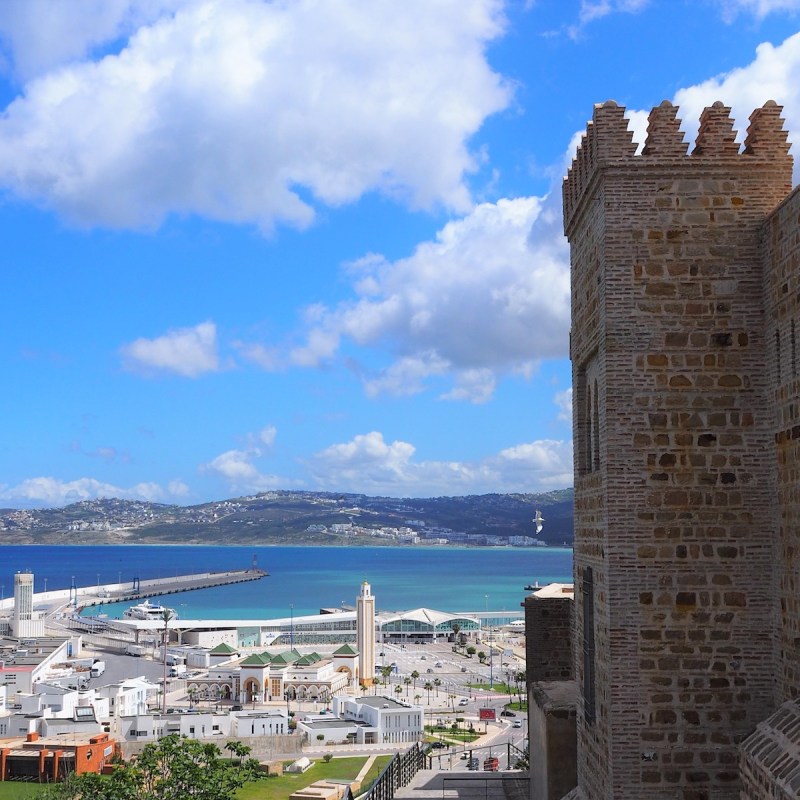
(Photo Credit: Kevin McGoff)
Talk of visiting Tangier conjures a sense of intrigue and the exotic. I was not disappointed as motorbikes whined, cars honked, and enticing aromas floated from kitchens while I walked the winding streets of this Moroccan port city. A brief notion of being part of a film noir surfaced when I heard, for the first time, the muezzin’s melodic call to prayer piercing the air of the Medina.
Videos by TravelAwaits
Tangier solidified its reputation as a haven for the underworld and spies during the Second World War. The film industry burnished this image by using the city’s medina — a walled old city within it — as a destination for James Bond and Jason Bourne to dodge the bad guys.
Long ago, Tangier served as a Phoenician trading post, and it later came under Roman rule. Arabs, Portuguese, British, French, and Italians all left their mark on Tangier, as well, having taken turns governing this port city over the centuries.
The mountains of Spain are clearly visible from the city, reaching for the clouds less than 17 miles from Tangier across the Gibraltar Strait. Perched along the narrow entry from the Atlantic into the Mediterranean, Tangier enjoys the most strategic position on the northern tip of Africa.
Tangier can be reached via multiple airlines and is a short hop from Spain by ferry. Efficient train service connects Fes, Marrakech, Rabat, and other cities to Tangier. A recently constructed expressway system serves travelers from the south.
Here are ideas to consider when planning your trip to Tangier.

(Photo Credit: Kevin McGoff)
1. The American Legation
Morocco’s diplomatic relationship with the United States dates to 1786 when the country was among the first countries to recognize the United States. Sultan Moulay Slimane granted the building which housed the American Legation to the United States in 1821. American diplomacy in Morocco and the region was carried out from this site until after the Second World War, and it now serves as a museum. The American Legation is the only U.S. national historic landmark outside of the United States.
Inside the legation is the Paul Bowles wing. Artifacts from the life of the author of The Sheltering Sky and long-time resident of Tangier are on display.
The American Legation is open Monday through Friday from 10 a.m. to 5 p.m. and Saturday from 10 a.m. to 3 p.m.

(Photo Credit: Kevin McGoff)
2. The Terrace Of The Lazy
The Terrace of the Lazy offers a sweeping view of Tangier’s port, the Gibraltar Strait, and the European coast across it. Interspersed among the benches adorned with idlers are a line of cannons pointing toward the sea. Situated at a high point on Boulevard Pasteur, this perch is a few steps from the Gran Café de Paris, just above the souks. This is a popular spot from which to photograph the hills of Spain not far across the strait.
3. Jewish History: The Moshe Nahon Synagogue
There is archeological evidence of a Jewish presence in Tangier dating to around 500 B.C. Moshe Nahon, a prominent citizen of Tangier, built his temple in the medina in the 19th century. After falling into disrepair, the synagogue’s elaborate decorations were restored in the 1990s. It now serves as a museum, open from 10 a.m. to 5 p.m. every day except Saturday.
Pro Tip: The synagogue is tucked in an alley off the Rue des Synagogues close to the American Legation. Request that your guide include this site on your tour.

(Glen Berlin / Shutterstock.com)
4. Haven For Artists And Writers
For centuries Tangier’s mélange of cultures, proximity to the sea, and the Mediterranean sun have attracted artists, writers, and expats. Beat writers of the 1950s Williams S. Burroughs, Jack Kerouac, and Allen Ginsberg found inspiration and an attractive lifestyle in Tangiers. Henri Matisse produced canvases while in Tangier, taking residence in the Grand Hotel Villa de France.
Before the Beats discovered Tangier, Mark Twain paid a visit; after the Beats left town, Anthony Bourdain, the Rolling Stones, and other rockers came to enjoy the sun and lifestyle of Tangier.
The onetime haunt of spies and literati, Café de Paris, remains a fixture in Tangier just beyond the medina. You can also have coffee where Burroughs, Kerouac, and other famous visitors once gathered at the Gran Café Central or the Café Tingis, both on the Petit Socco square.

(Photo Credit: Kevin McGoff)
5. Caid’s Bar At El-Minzah Hotel
Tucked downstairs in the El-Minzah Hotel is Caid’s Bar. This one-time artists’ hangout is reputed to be the model for Rick’s Bar in the film Casablanca.
We found the waiters smartly dressed, and piano music accompanied wafts of cigarette smoke swirling about the old bar. There is an outdoor terrace overlooking the pool if idling in a smoky bar has no allure.
Photos of film stars, directors, and singers that passed through the Hotel El-Minzah line the courtyard outside Caid’s.

(Gert-Jan van Vliet / Shutterstock.com)
6. Shopping The Souks For Souvenirs
Compared to the maze of the souks of Marrakesh, I found my way out of Tangier’s souks with relative ease. The merchants were friendly, some gently coaxing us to have a look at their wares. Handwoven rugs, leather goods, and handcrafts graced the narrow shops. Even when I passed by without popping in, shop owners offered a friendly “shukran” — thank you — accented by a slight bow and touch of a fist to the heart.
Pro Tip: Visit the fish market in the souk during the morning. The scene is lively. Countertops overflow with the day’s catch, and animated locals haggle loudly with the fishmongers.

(Photo Credit: Kevin McGoff)
7. Beit Hahayim, Tangier’s Jewish Cemetery
According to our guide, the oldest grave in Tangier’s Jewish cemetery, Beit Hahayim, dates back to 1367. Situated in a shady grove at the edge of the medina, the tombstones of over 1,000 graves overlook the nearby port.
The cemetery is open daily from 10 a.m. to 6 p.m. but is closed on Sunday.

(Color Chaser / Shutterstock.com)
8. Kasbah Museum
Housed in the palace of a former sultan at one of the highest points in Tangier is the Kasbah Museum. Artifacts from different periods of Morocco’s unique history are on display. The palace housed British and Portuguese governors during their respective periods of rule in Tangier. The museum is open daily from 10 a.m. to 6 p.m. (closed on Tuesday), and the building is itself worth a visit.

(Photo Credit: Kevin McGoff)
9. Day Trips West From Tangier
Tangier is a convenient base from which to experience the countryside along the Atlantic coast. Taxis and tour companies will give you a lift, but it is easy to rent a car and explore on your own. The roads are in great shape and directions easy to follow. Moroccans drive on the same side of the road as Americans and continental Europeans.
Asilah
Less than an hour south of Tangier is Asilah. The Portuguese fortified the ancient ramparts of this coastal city in the 15th century. Painted a bright white, the houses of Asilah present a sharp contrast to the sky and brilliantly colored shutters on some homes.
Pro Tip: If visiting Asilah in August, enjoy the International Cultural Festival. Music and art, including mural painting on the walls of the medina’s houses, are part of the festivities.
Cave Of Hercules
North along the coast from Asilah is the Cave of Hercules. Legend has it that the mythical giant rested here while on his way to fetch the golden apples from the Garden of the Hesperides. Formed in the shape of the African continent, the cave’s “window” looks out on the Atlantic Ocean.
The churning waters of the Mediterranean Sea and the Atlantic Ocean collide at Cape Spartel. Mariners have been guided into the Strait of Gibraltar by the cape’s lighthouse since the 1860s.
These sites are west of Tangier, all easily visited in a 1-day trip.
Pro Tips: If you elect to rent a car, avoid congested city driving by picking up and returning the car at Tangier’s Ibn Battouta Airport, a 20-minute taxi ride from the center of town.

(Olena Znak / Shutterstock.com)
10. Heading East, To The Rif
Leave Tangier for a day heading east, and you will soon be in the Rif Mountains. A bit off the beaten path, the mountainside town of Chefchaouen is an easy 2-hour drive. Known as the Blue City, Chefchaouen is like no other, with its buildings cast in azure and white. The caretaker gave us a pleasant tour of the interesting garden in the kasbah, or fortress.

(Photo Credit: Kevin McGoff)
Best Restaurants In Tangier
Le Saveur De Poisson
The fish is fresh and served in a no-frills style on sturdy wooden tables at Le Saveur de Poisson. Le Saveur takes no reservations; the line forms at the front door of this set-menu seafood restaurant located on a stairway leading to the medina. The restaurant is open for lunch and dinner every day except Friday.
El Morocco Club
Experience a sense of Tangier back in the day with a visit to the dimly lit, intimate piano bar at The El Morocco Club. Drop by for an aperitif before having dinner in El Morocco’s restaurant upstairs. Traditional Moroccan cuisine is served with a gastronomic touch.

(Photo Credit: Kevin McGoff)
The Soul Of Tangier
Though Tangier is evolving, once you’re within the labyrinth of the souks and ancient walls of the medina, the soul of ancient Tangier remains. Perhaps the spies have moved along, but the aromas, noise, and charm that have been drawing expats and voyageurs over the centuries still await curious travelers.
Pro Tip: If approached and offered services as a guide, politely decline and keep walking. Hire only a licensed guide to shepherd you through the sites of Tangier.

